SOWK 487 Week 05 - Working with Families Part II
A presentation at Heritage University @ CBC Week 05 in in Pasco, WA 99301, USA by Jacob Campbell
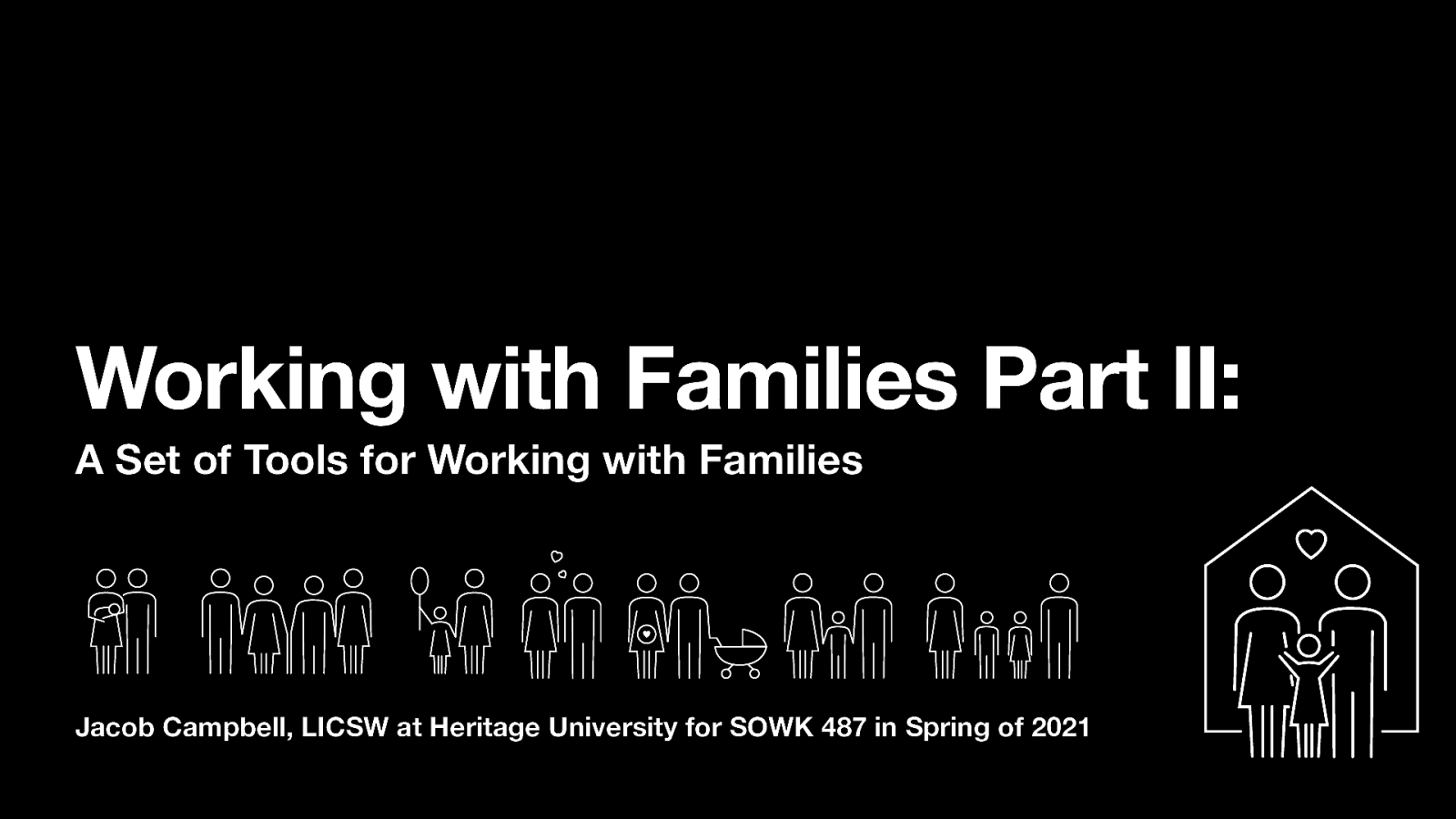
SOWK 487 Spring 2021 Planning: Class 05
Time: Wednesday’s from 5:30-8:15
Date: 02/10/21
Content: Working with Families II
Reading Assignment: Prest and Protinsky (1993)
Due Dates:
- A-01: Synchronous Class Engagement Attend class
- A-02: Asynchronous Class Engagement “What types of roles do we see in ourselves” due Sunday 02/14/21 at 11:55 PM via Flipgrid
- Read Prest and Protinsky (1993)
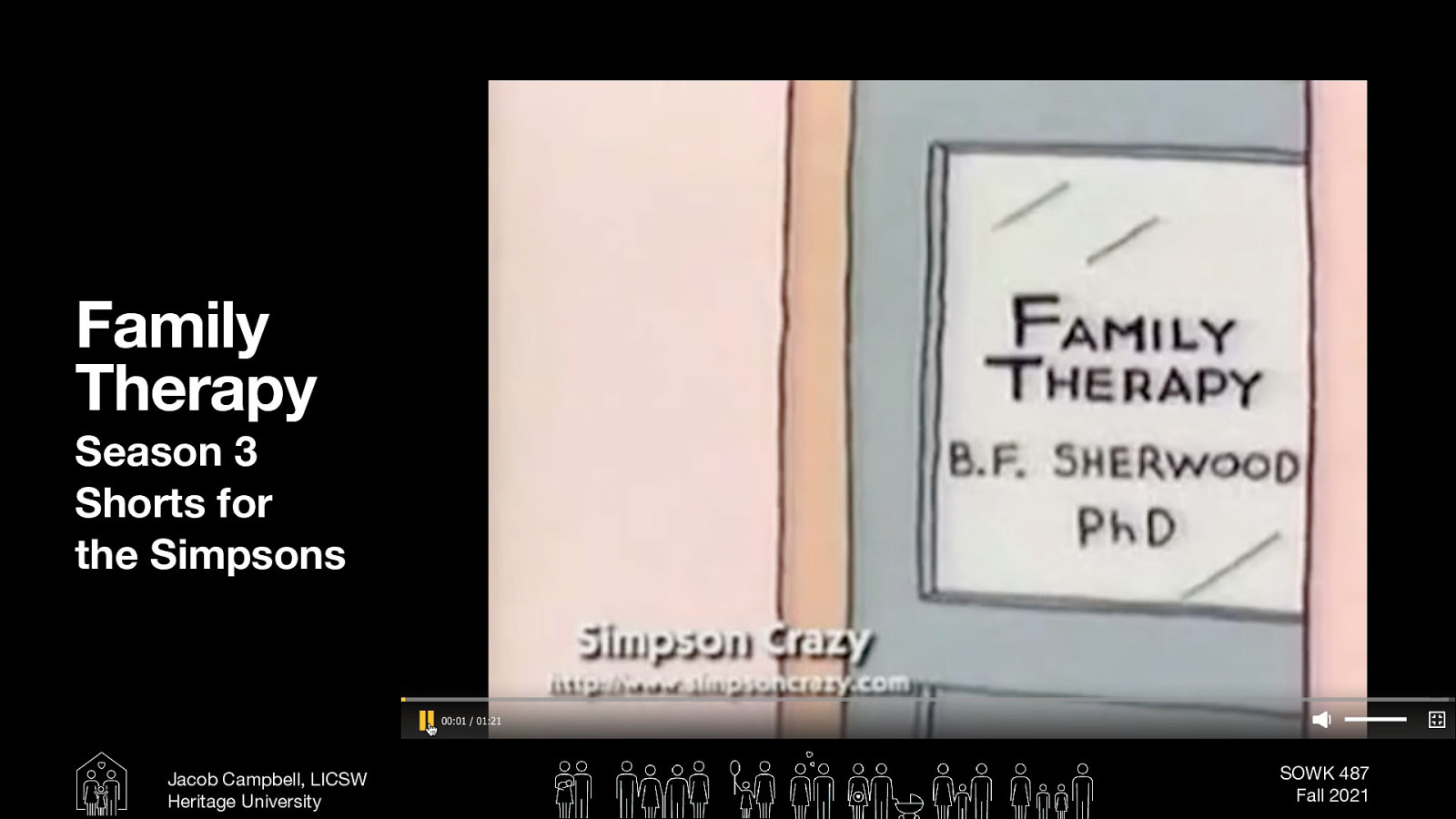
Family Therapy
Season 3 Shorts for the Simpsons
[Whole Class Activity] Watch the Family Therapy Video clip of the Simpsons.
Today we will be talking about working with families and what that looks like.
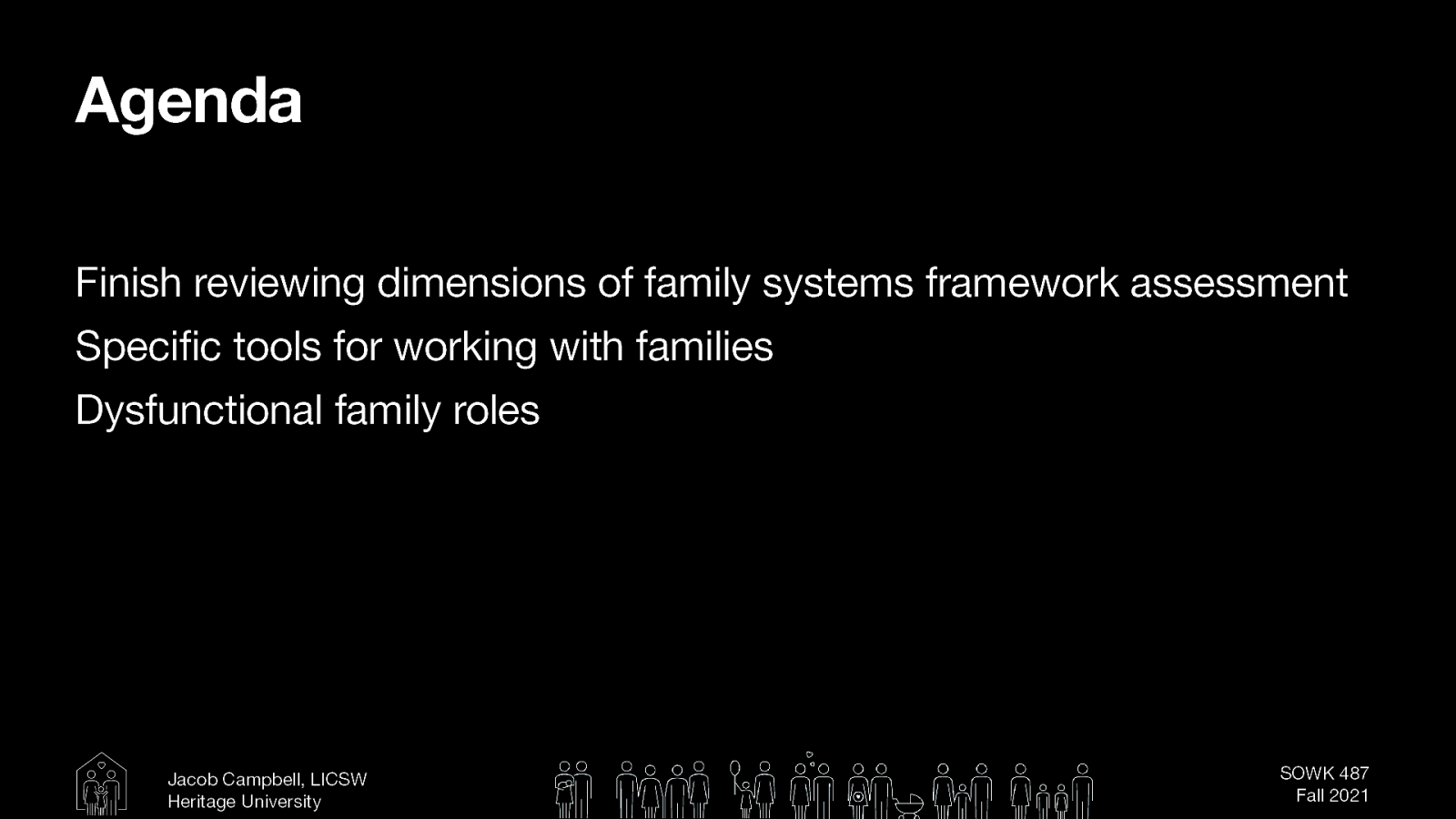
Agenda
- Finish reviewing dimensions of family systems framework assessment
- Specific tools for working with families
- Dysfunctional family roles
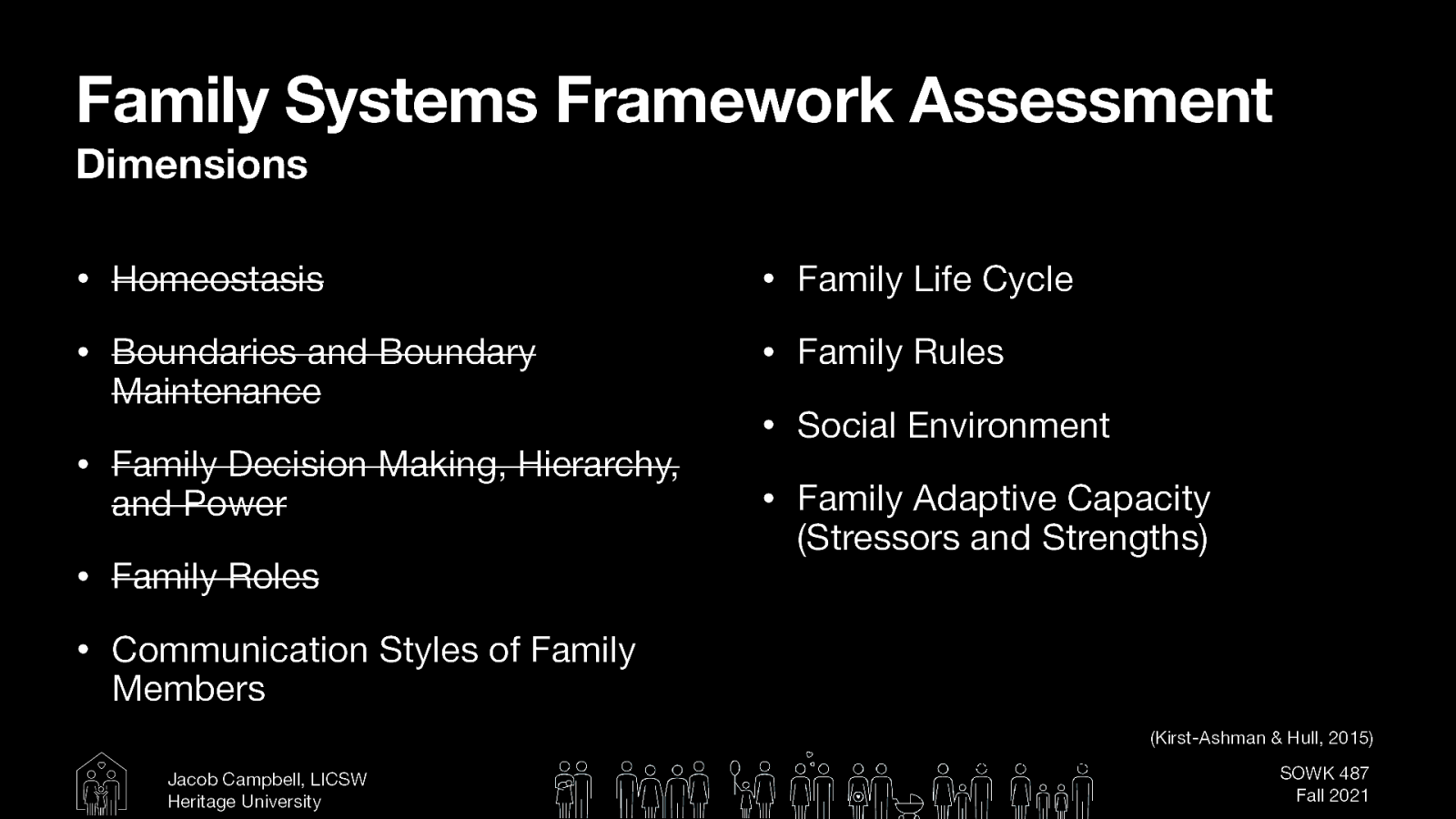
Dimensions of a Family Systems Framework Assessment
We talked about some of these last week, but I wanted to get through the rest of the sections this week
- <s>Homeostasis</s>
- <s>Boundaries and Boundary Maintenance</s>
- <s>Family Decision Making, Hierarchy, and Power</s>
- <s>Family Roles></s>
- Communication Styles of Family Members
- Family Life Cycle
- Family Rules
- Social Environment
- Family Adaptive Capacity (Stressors and Strengths)
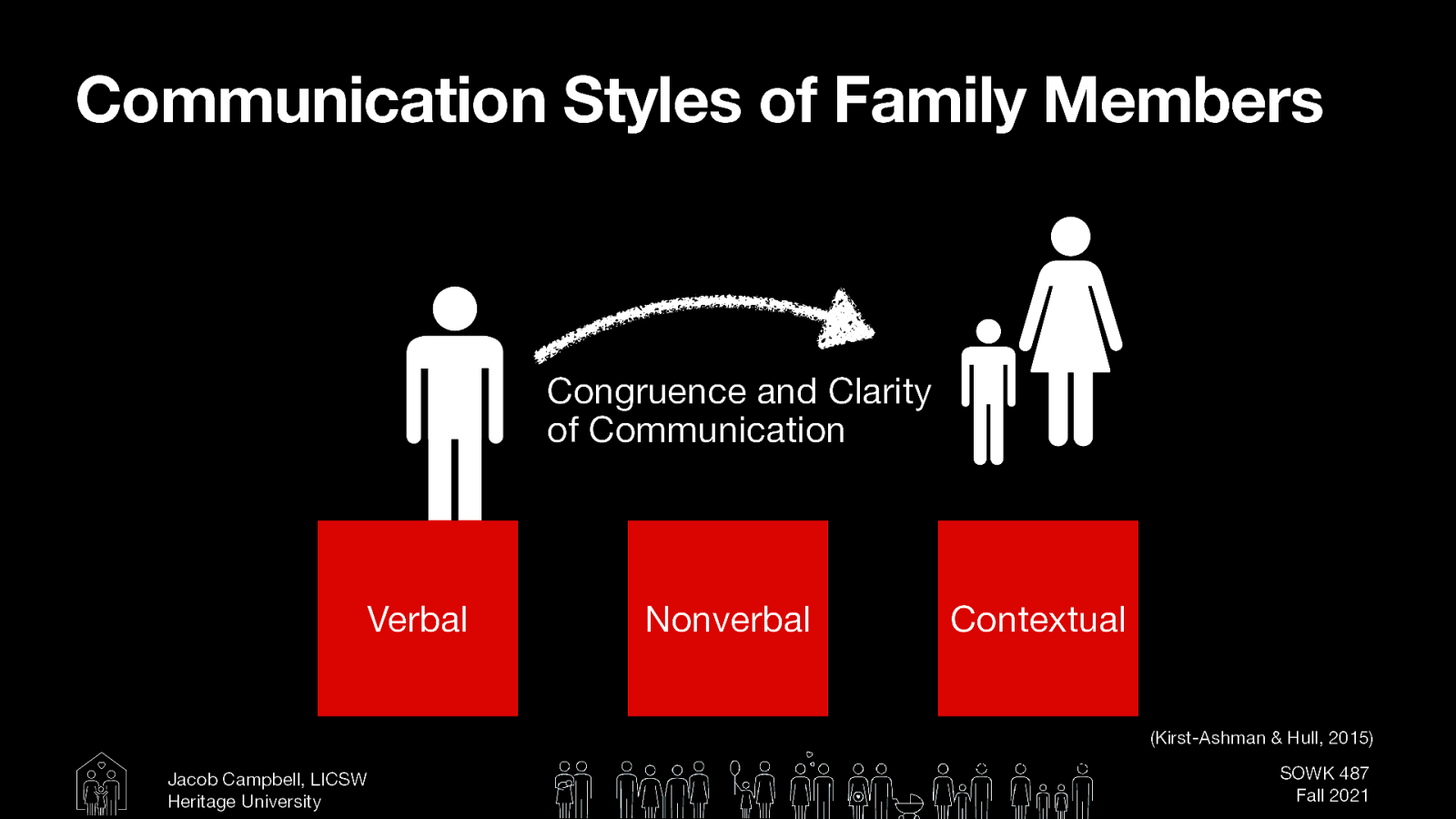
ommunication Styles of Family Members
Looking for patterns and styles of communication with in families is another important area to consider. This frequently means examining…
Congruence and Clarity of Communication, which includes verbal, non-verbal and contextual.
[Whole Class Activity - Discussion] What are some of the types of things that we are looking for verbally and non verbally (as discussed in micro skills last semester)?
Especially in working with families, we are on the look out for patterns
- Watching for patterns
- Verbal communication patterns…
- Who talks a lot
- Who talks rarely
- What tone of voice does mom use with son… etc
- Nonverbal communication can involve facial expressions, eye contact, and posture
- Where do they all sit?
- How close do they sit
- [Story] Working for the CRC, and watching the seating for while doing family sessions.
- Verbal communication patterns…
- Using techniques
- Being warm, empathic, and genuine
- Using interviewing techniques.
- Family interaction and communication are more complicated because more individuals are involved.
Looking for patterns and styles of communication with in families is another important area to consider. This frequently means examining…
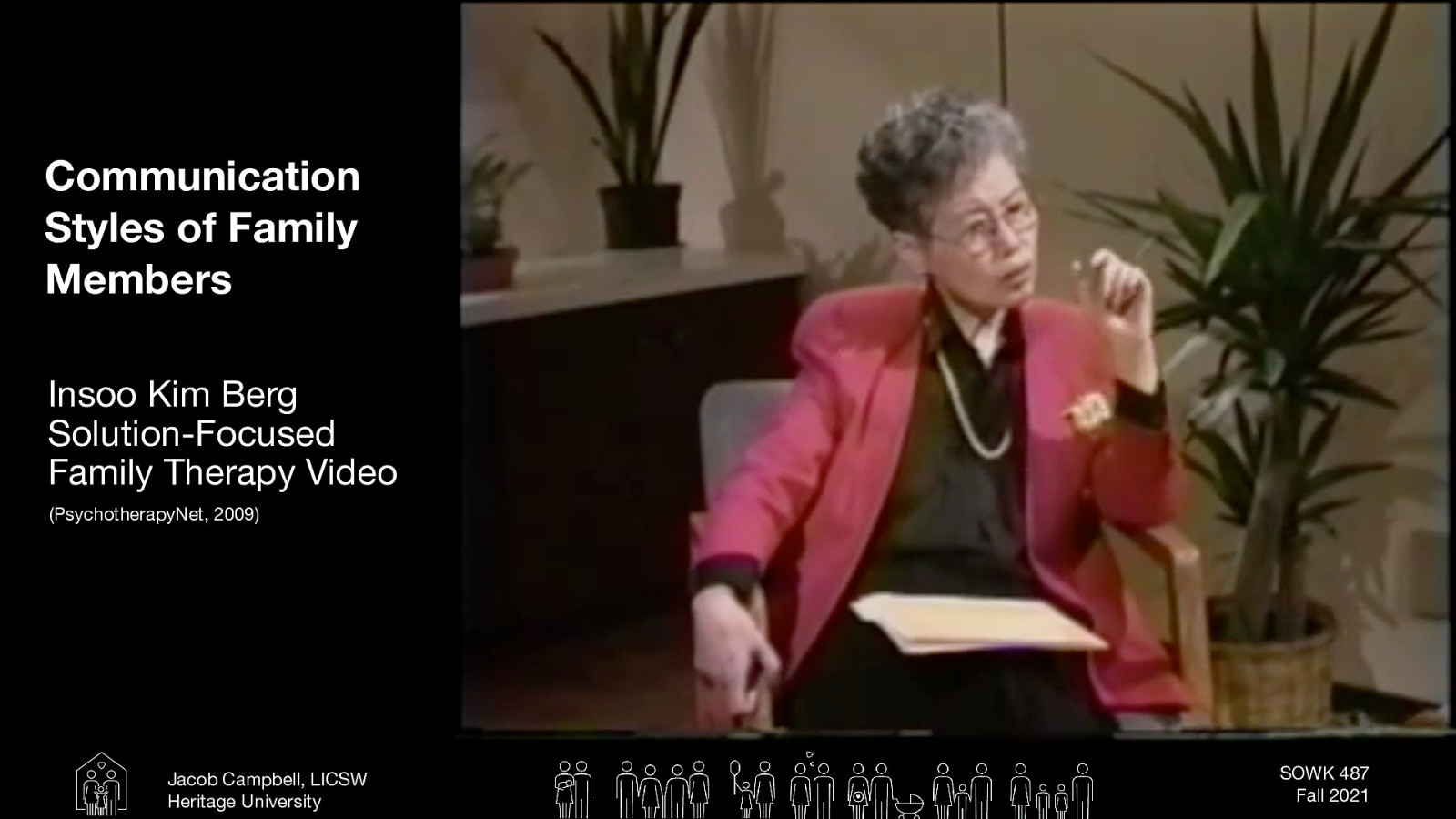
Insoo Kim Berg Solution-Focused Family Therapy Video
Insoo Kim Berg Solution-Focused Family Therapy Video. (2009, June 29). Insoo Kim Berg Solution-Focused Family Therapy Video. Retrieved from https://www.youtube.com/watch?v=6Fe8D0hAQh0
PsychotherapyNet. (2009, June 29). Insoo Kim Berg solution-focused family therapy video [Video]. YouTube. https://youtu.be/6Fe8D0hAQh0
We are going to watch a short video clip of Insoo Kim Berg doing family therapy. We are not watching necessary for techniques, but what do you observe about the verbal / nonverbal communication of the family.
- [Discussion] Does anybody know who Insoo Kim Berg is? Solution-focused brief therapy
- [Discussion] What do you observe?
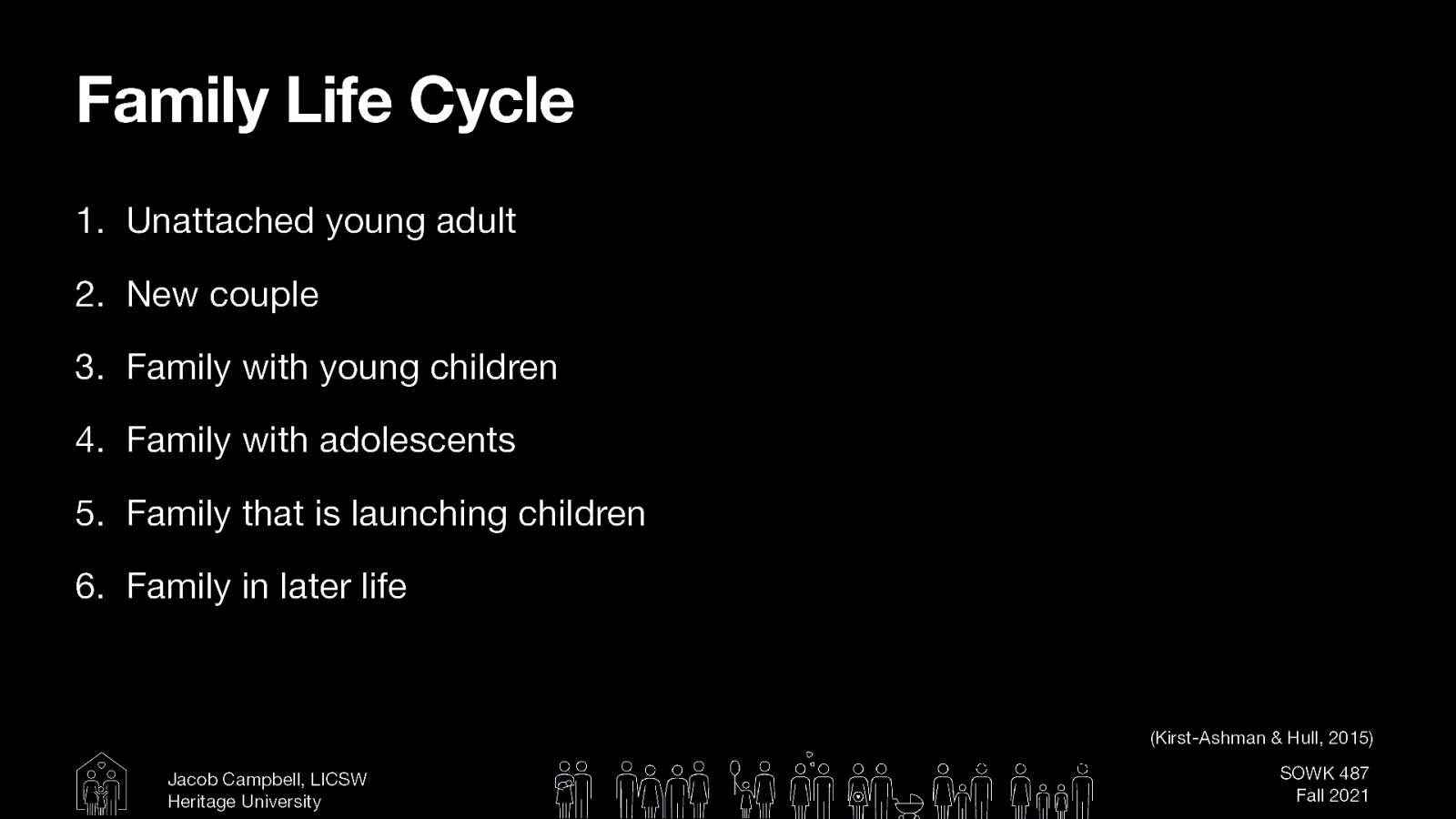
Family Life Cycle
One way of looking at a families stage in their own life cycle
- Unattached young adult
- New couple
- Family with young children
- Family with adolescents
- Family that is launching children
- Family in later life
at each of these stages families face various different tasks to complete.
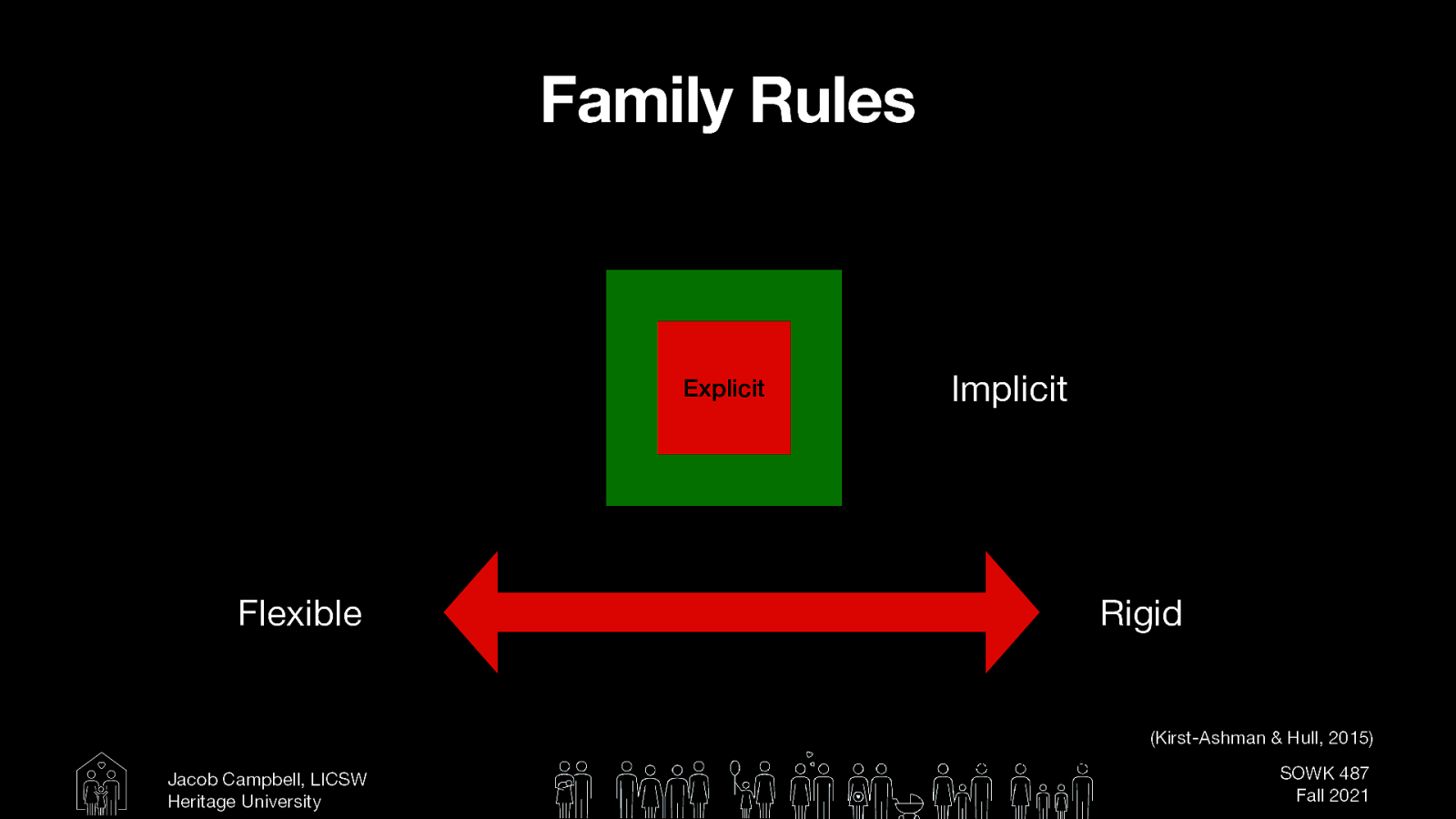
Family Rules
The explicit and implicit rules found in a family system may be either flexible or rigid, depending on con- text and time.
[Whole Class Activity] What are some rules that families might have?
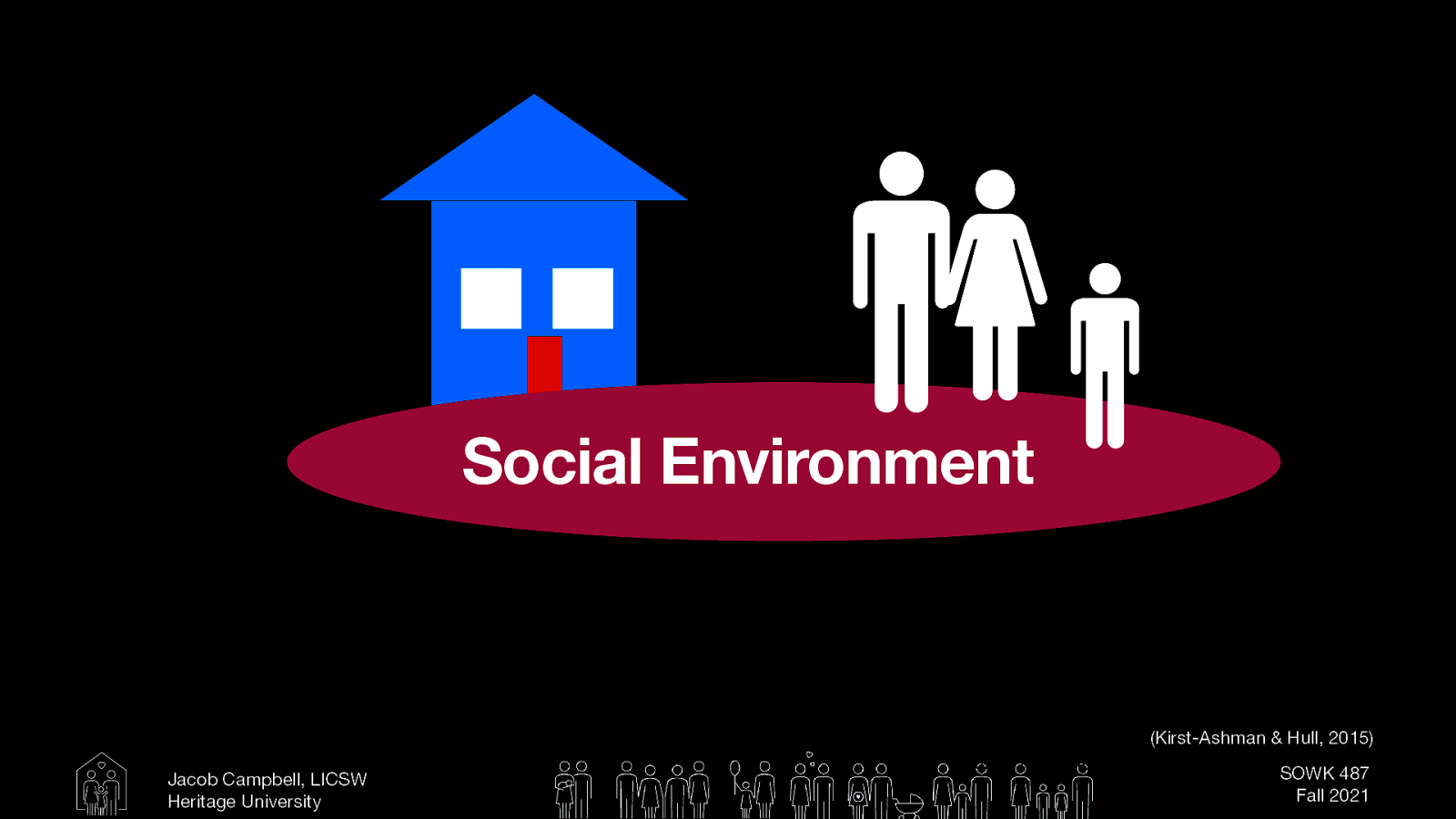
Social Environment
Social environment is also an important aspect to look at.
Think about all of the different contexts and applying ecological perspective to a family.
Talk about client communities (Iraqi, Cuban, etc.) that I’ve worked with
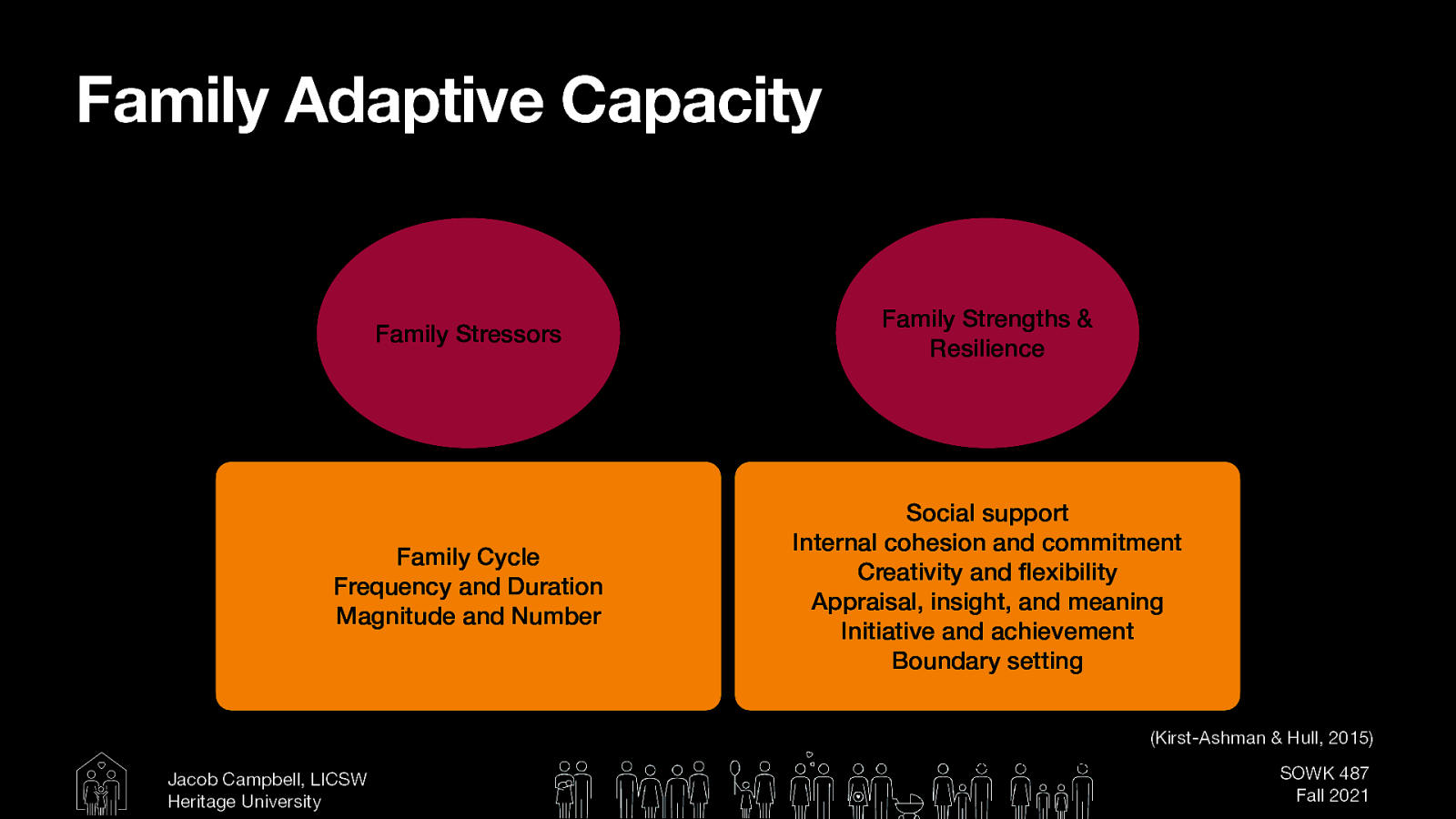
Family Adaptive Capacity (Stressors and Strengths)
“The adaptive capacity of any given family refers to the extent to which the family can achieve its functioning goals, given the demands of family and social life. As the family faces demands from its environment and challenges from its members, its capacity to adapt is a central property of the ability to maintain itself as a cohesive unit.” (p. 267)
- These stressors can be categorized by
- Family Cycle: Normative (normal) vs nonnormative (not expected)
- Frequency and Duration: Acute, Chronic, Episodic
- Magnitude and Number: Stressful life event vs daily hassles
Family Strengths and Resilience
- Social support, from the community as well as from kinship bonds. Families who have active and vital social support networks have ready access to coping resources.
- Internal cohesion and commitment. Families are able to adapt to adversity when family members have a strong sense of dedication to each other and when their patterns of communication lend themselves to a mutual understanding of family members’ thoughts, ideas, and feelings regarding adversity.
- Creativity and flexibility. Families that strive for creative solutions to problems, including especially demonstrating flexibility in role assignments, enable families to find solutions to stressful situations.
- Appraisal, insight, and meaning. When families strive to understand their difficulties and to find affirmative meaning in them, they have an increasing ability to sustain their problem-solving efforts under stress. Very often appraisal and insight are linked to family spirituality and belief systems.
- Initiative and achievement. Families who are action-oriented tend to approach problem-solving using positive coping strategies such as cognitive coping, problem-solving, and constructive emotional regulation strategies.
- Boundary setting. Families with a strong sense of family structure will seek to shield its members from unhelpful, unhealthy, and destructive influences.
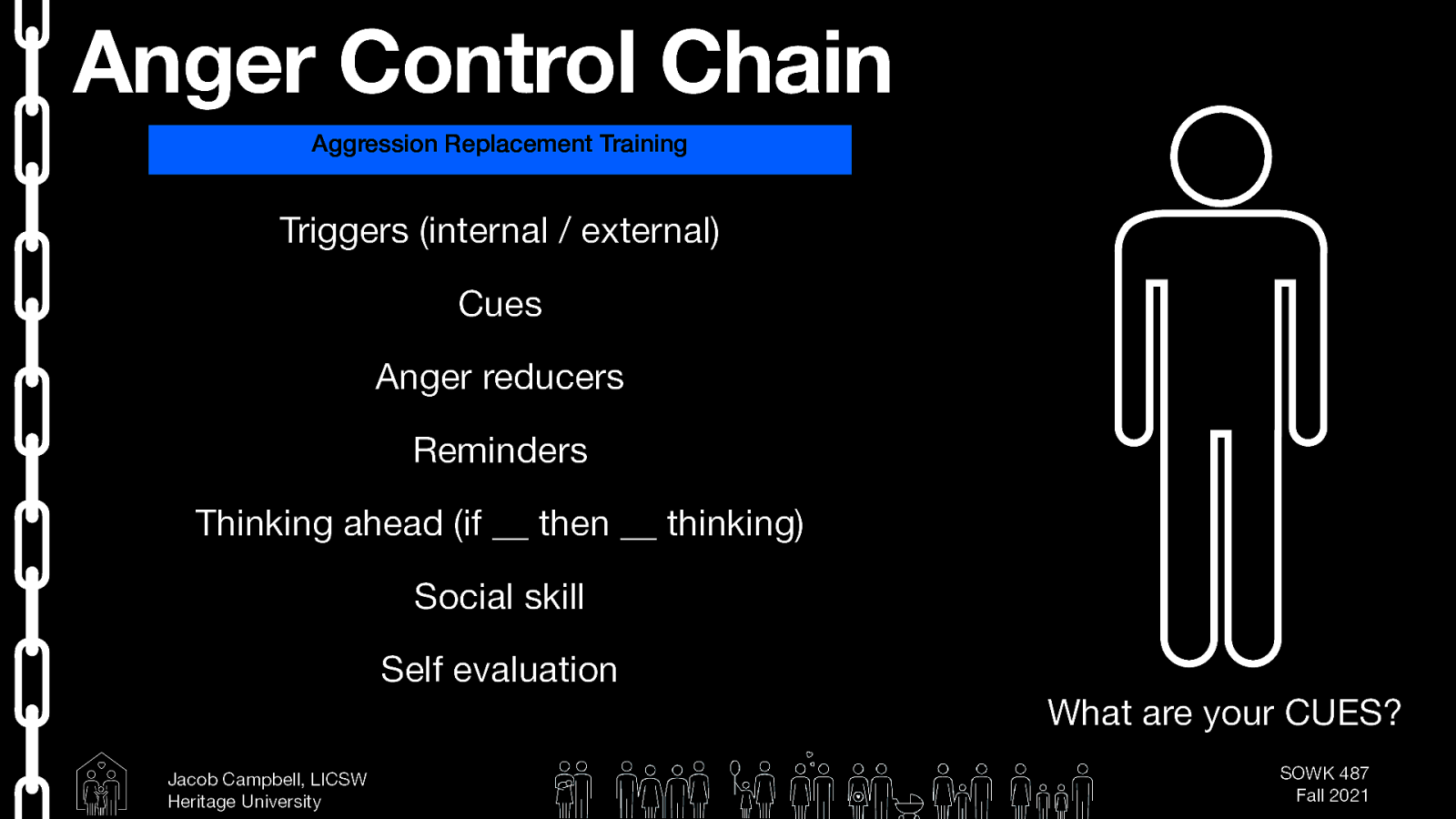
What Are My Cues
This activity is based both on work done ART and from Guiding Good Choices Parenting Classes. In ART the following are the sections of what is called the anger control chain.
- Triggers (internal / external)
- Cues
- Anger reducers
- Reminders
- Thinking ahead (if __ then __ thinking)
- Social skill
- Self evaluation
I want to show you an activity you could do in groups / with families to help brainstorm what a youth’s cues are.
[Whole Class Activity] Draw an outline of a person. Have people brainstorm what they feel like when they get upset. Using outrageous drawings.
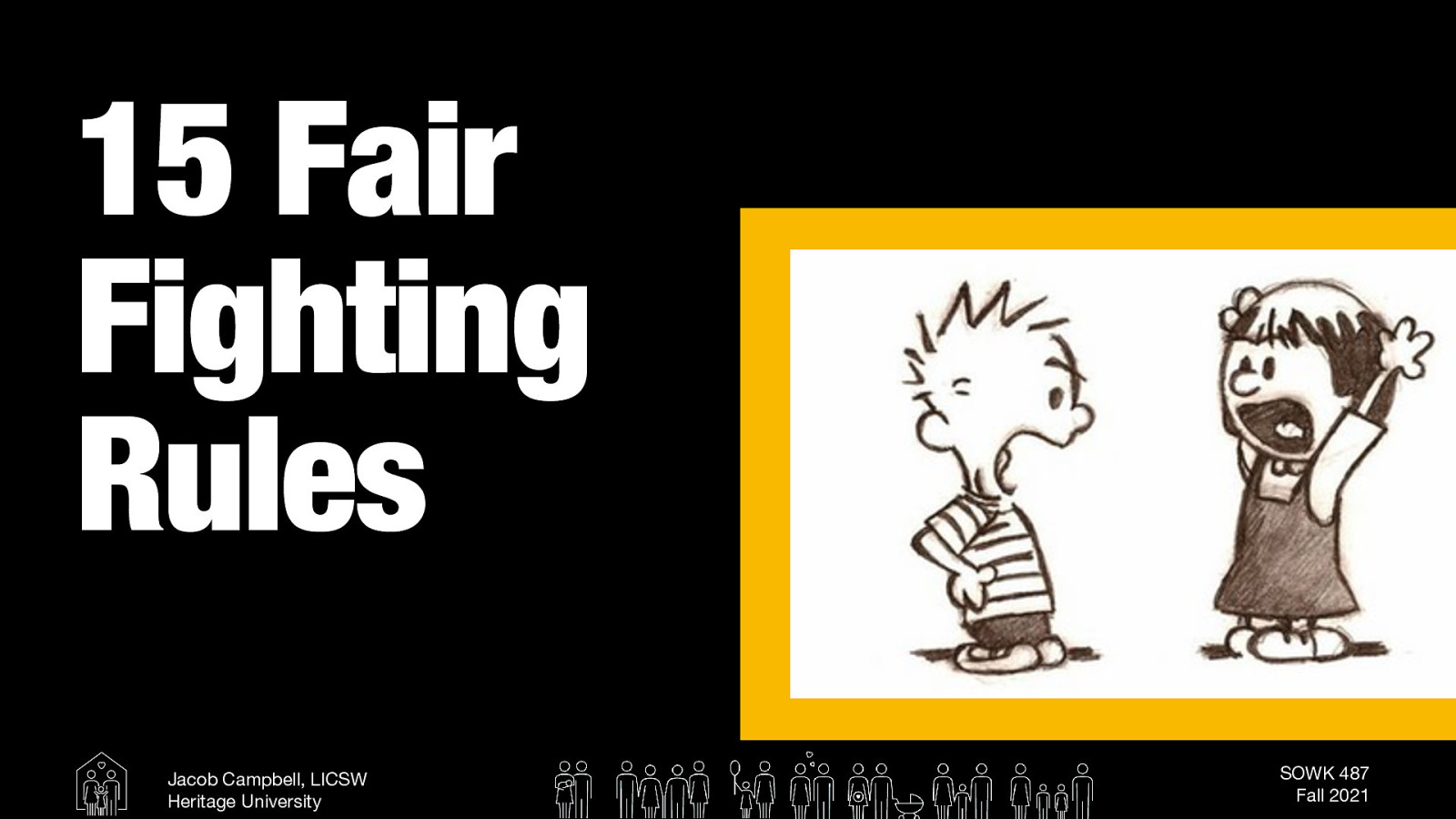
15 Fair Fighting Rules
The following is a handout I used to use many times when I have been working with families who have conflict.
One way that I frequently used it was to talk about it point by point.
[Whole Class Activity] Demonstrate with volunteers going through the form for a couple of minutes.
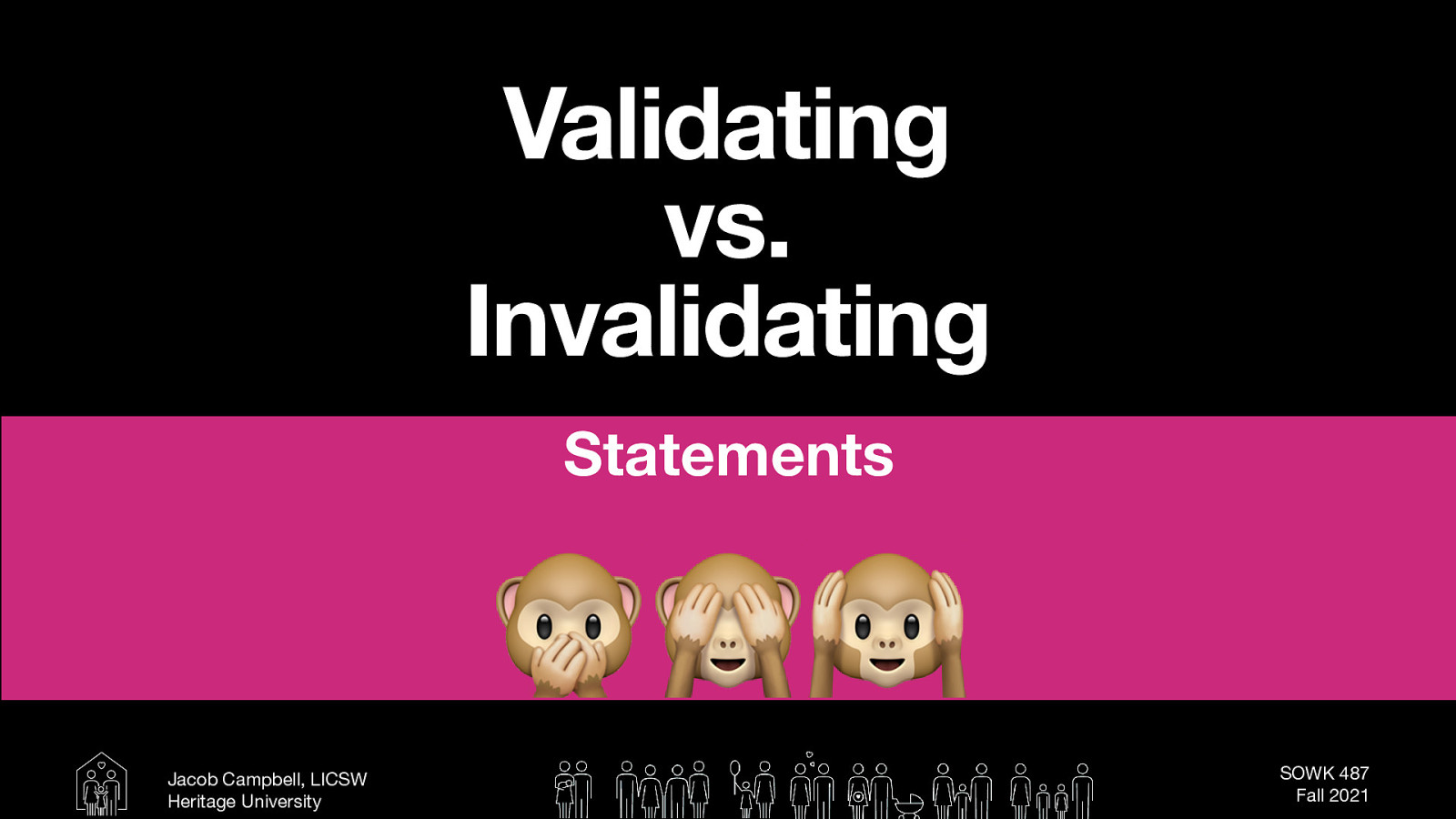
Validating vs. Invalidating Statements
The following is a good list of validating vs. invalidating statements.
[Whole Class Activity] Give class some time to review the material. What are some different ways that somebody could use this with a family?
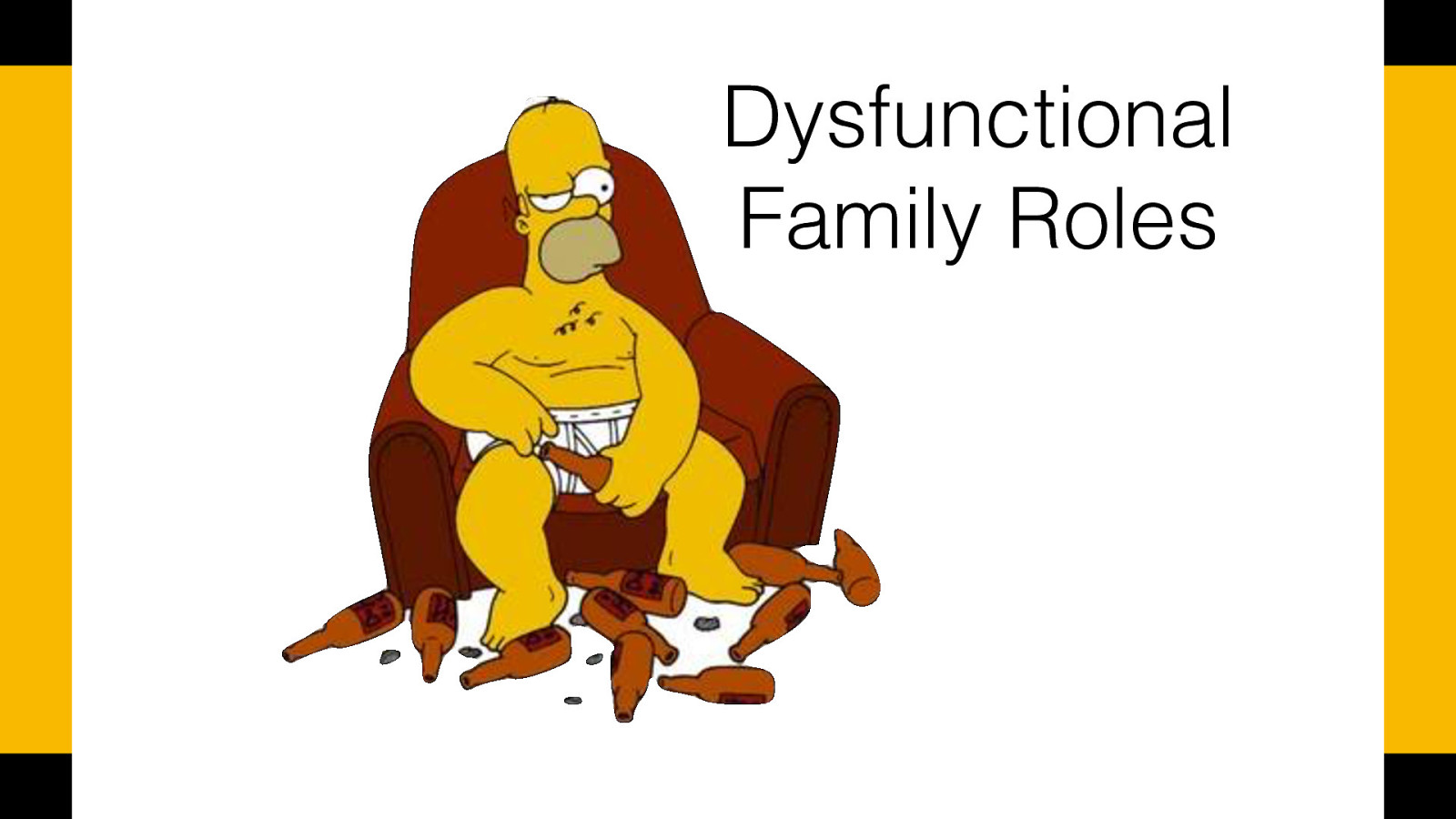
Dysfunctional Family Roles
There can be a number roles that family members might fall under. Sometimes, especially in literature regarding substance abuse, there are roles described as co-dependent or dysfunctional considered common. We are going to spend some time examining those.
Also, something to consider. There is no real scientific backing to some of this, it is taken as standard and frequently seen, but has not be scientifically verified.
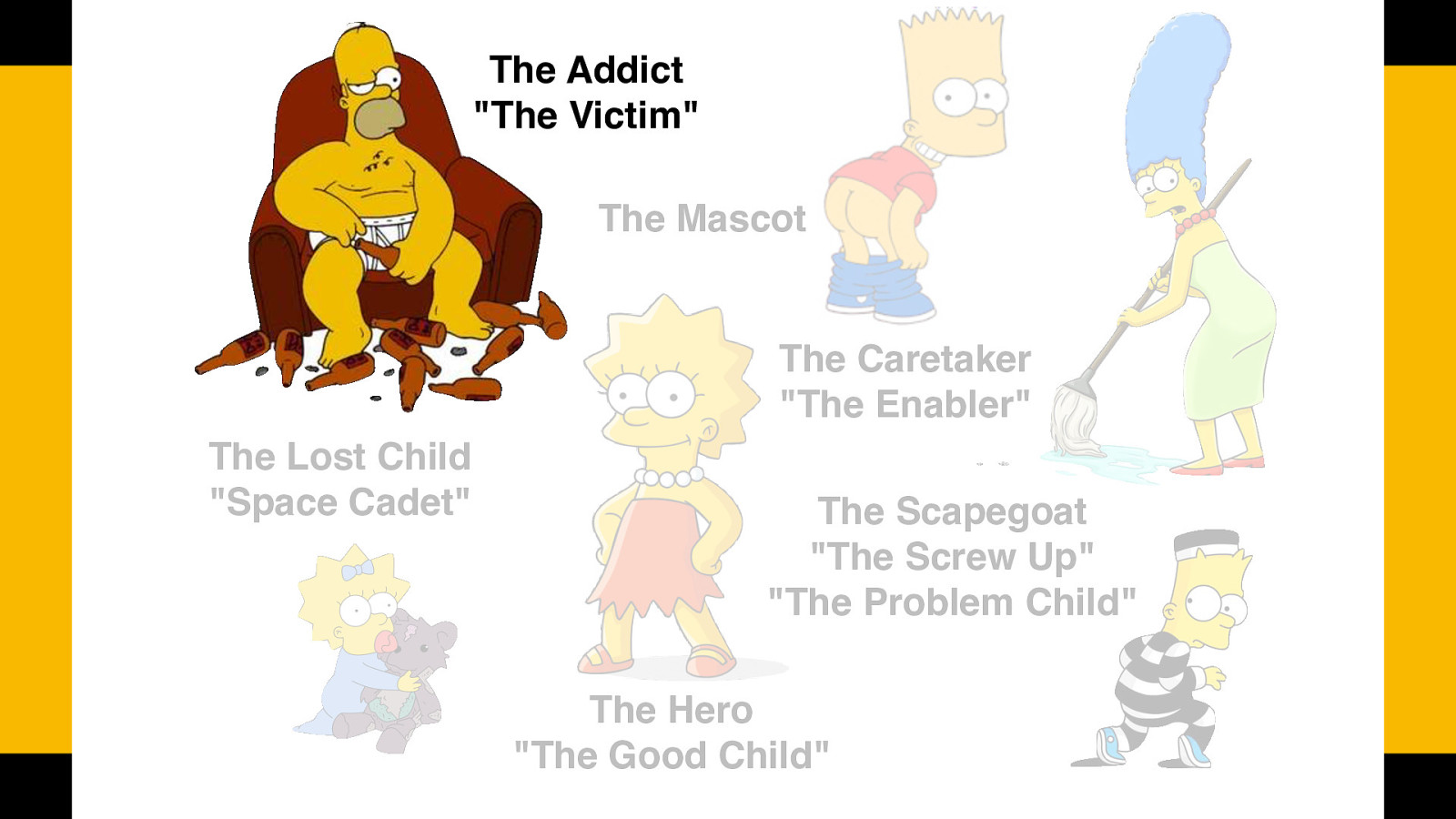
Addict: The Victim
The entire family life revolves around the addict or alcoholic. Each codependent role has been taken on in order to “make sense” of, and handle, the dysfunction in the everyday life of the family.
Understanding the addict is very important. Of equal importance is knowing that by making changes in your own actions, you can stop supporting the addictive behavior of your loved one.
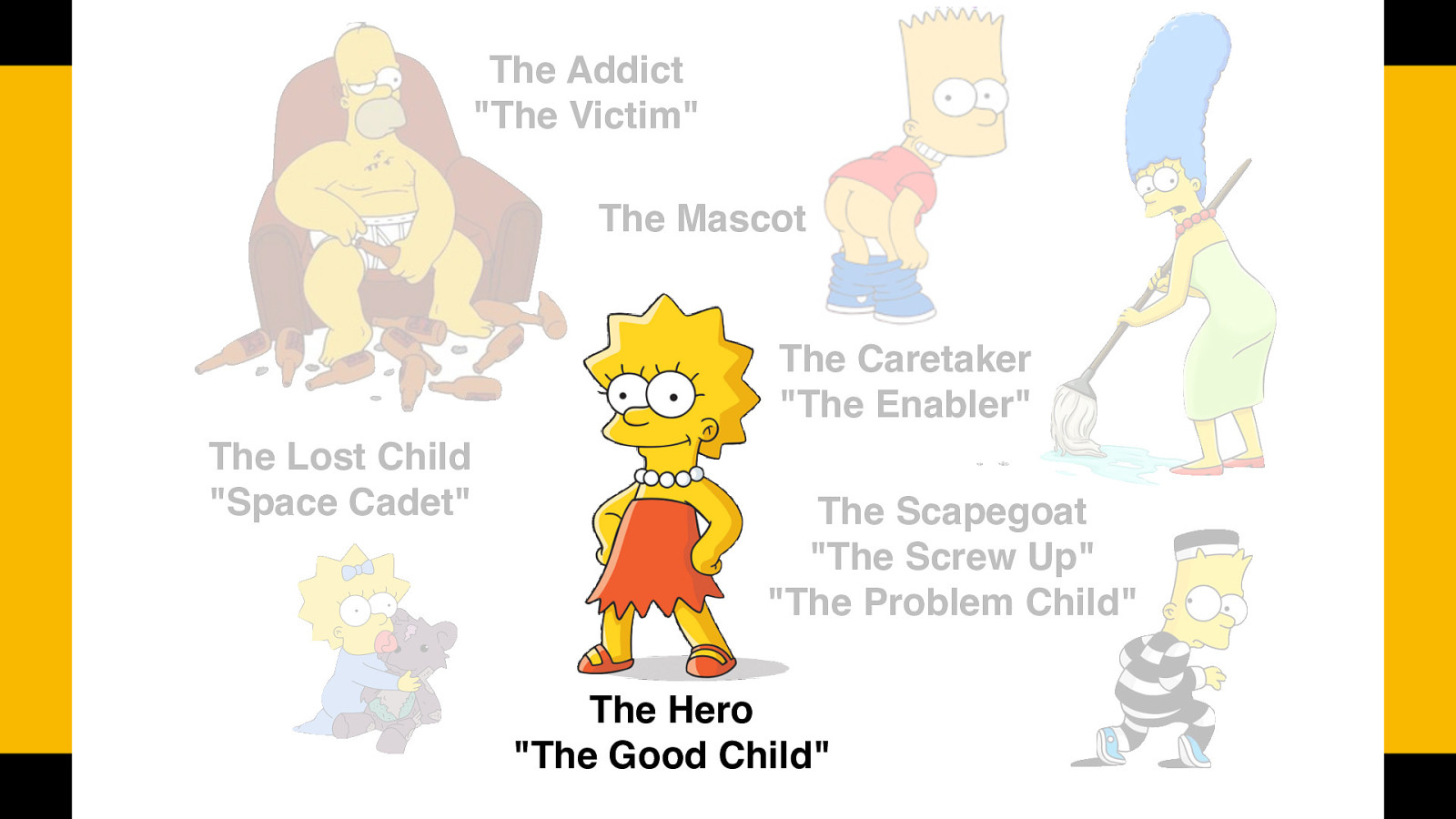
The Hero
This family member (often the oldest child) devotes his time and attention to making the family look “normal” and without problems.
- By overachieving and being successful in school, work or social activities.
- The Hero feels he can mask or make up for the dysfunctional home life.
- Everyone sees the Hero as kind, helpful and positive.
- Inside
- Heroes often feel isolated inside
- Unable to express their true feelings.
- They may have difficulty with intimate relationships in later life
- May suffer from illness related to stress.
- They are often workaholics as adults.
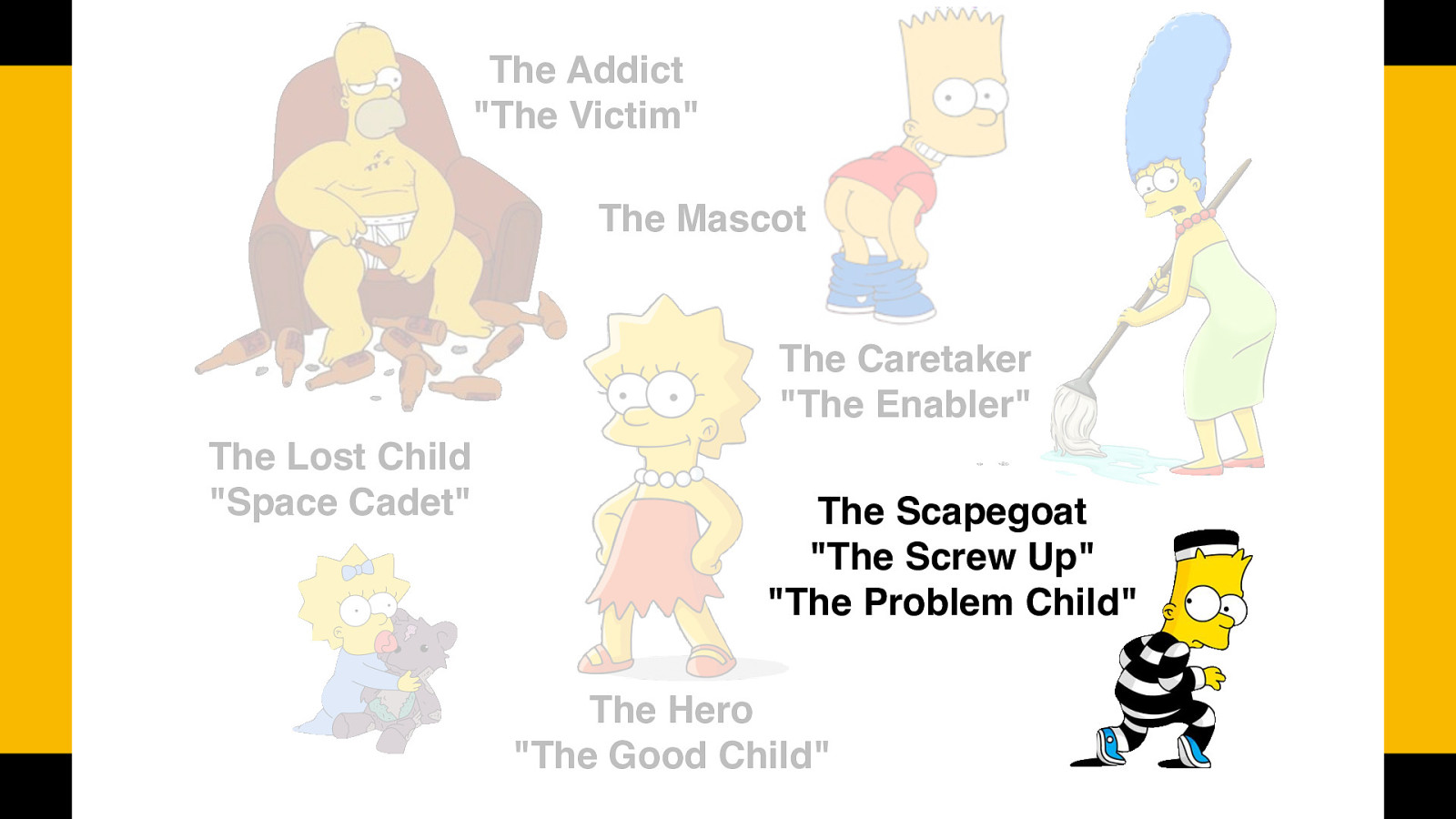
The Scapegoat
The Scapegoat (often the second born) always seems defiant, hostile and angry. They are perpetually in trouble at school, work or in social situations…
- Often our target client….
- Their behavior turns the focus away from the addict or alcoholic in the family
- They may also be reacting to the attention that the hero child receives
- Frequent turns to high risk behaviors as a way to express their inner feelings of emptiness.
- The Scapegoat may experiment with drugs or alcohol.
- They may become sexually active at an early age, or get into frequent fights.
- They can be very clever, and leaders in their own peer groups.
- Often the groups that they choose to associate with are gangs or other groups that do not present healthy relationships.
- All of these negative behaviors need to be seen as a cry for help!
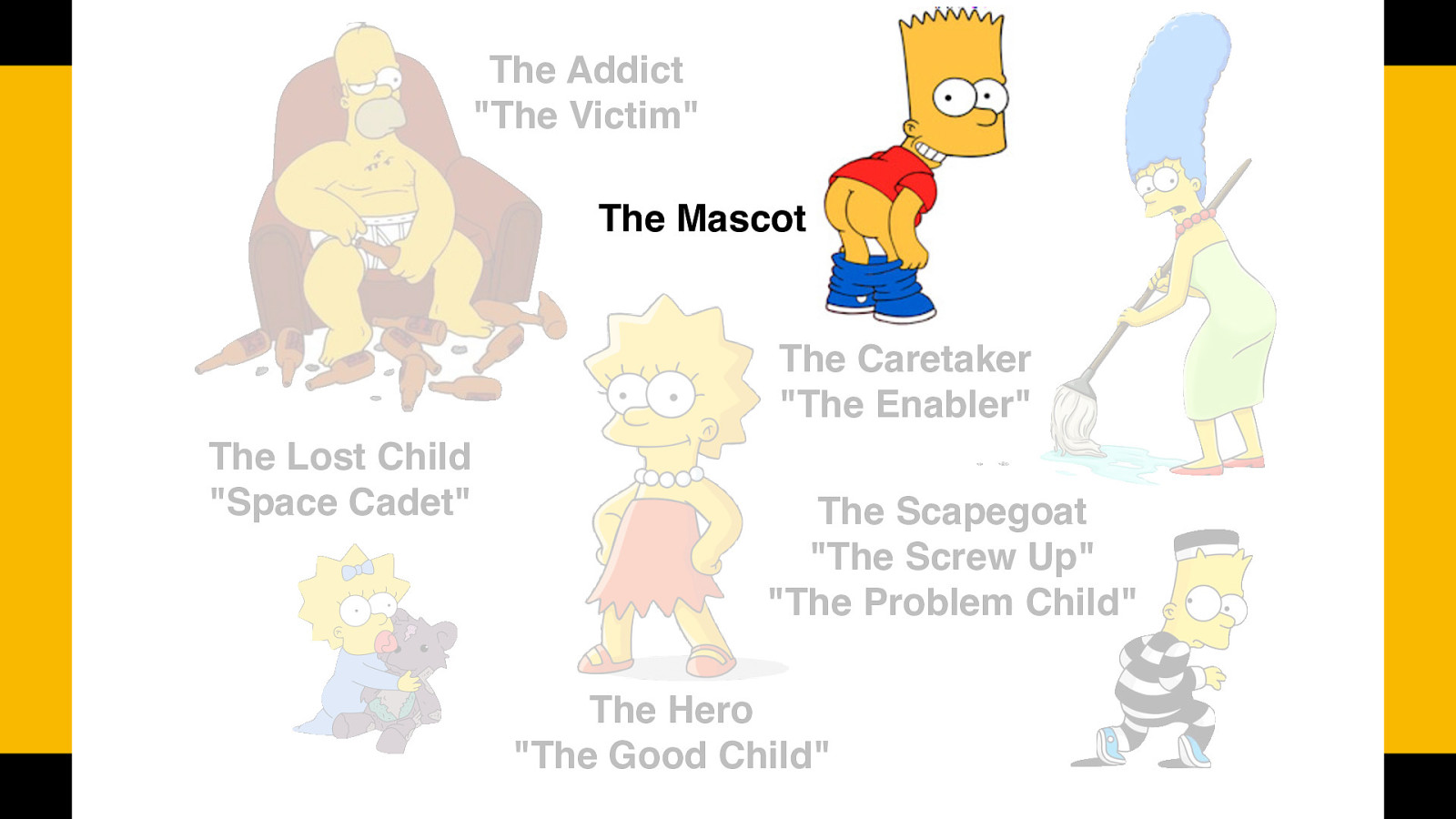
The Mascot
This family member is often the youngest child in the family. They are the court jester, trying to get everyone to laugh. They do this unconsciously to improve the atmosphere in the dysfunctional household, as well as turn the focus away from the addict or alcoholic.
- The rest of the family may actually try to protect their “class clown” from the severity of the addiction, and whatever other problems exist within the family.
- The problem with this is that The Mascot may run away from problems, even as an adult, or continue to use humor to focus away from problems.
- The Mascot is often busy-busy-busy.
- They become anxious or depressed when things aren’t in constant motion.
- This hyperactivity makes it hard for them to concentrate very long on any one particularly thing, and this makes school or work difficult.
- Some mascots turn to drugs or alcohol to help them “slow down” or handle their anxiety.
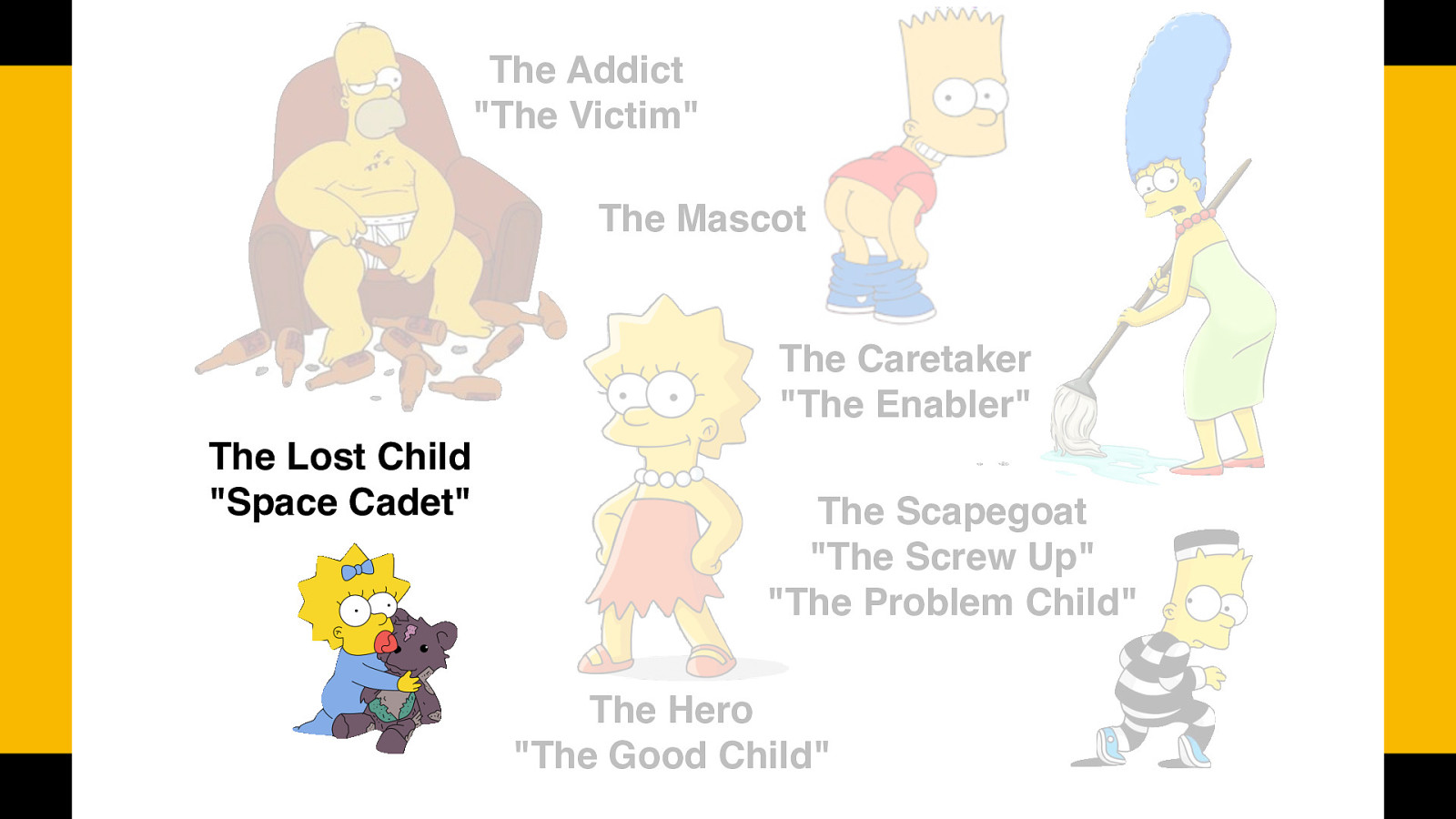
The Lost Child
The lost child basically disappears. They become loners, or are very shy. They feel like strangers or outsiders, not only in social situations, but also within their own families. Often they feel ignored, and that they don’t matter.
- Their way of handling the addictive behavior in the family is to draw away from interaction with family members.
- The Lost Child often has a rich inner life.
- Because they don’t interact, they never have a chance to develop important social and communication skills.
- The Lost Child avoids trouble, even if they truly need something.
- Sometimes they develop physical problems, such as asthma or obesity, in order to gain attention. They may never even realize they are doing this.
- As adults, they may never marry, or may have difficulty having an intimate relationship.
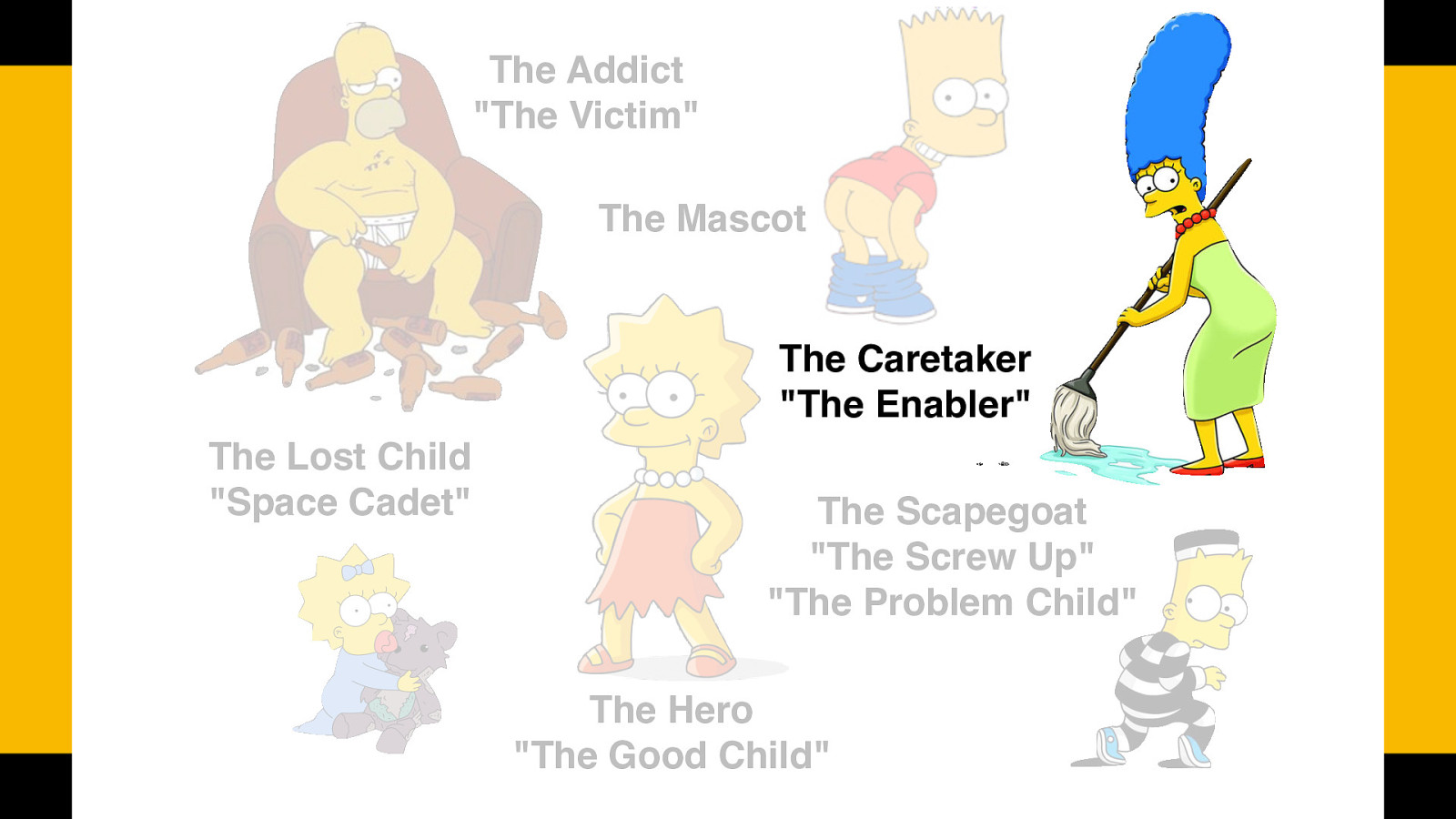
The Caretaker
Next is the caretaker, but another descriptive word for this type of codependent family role is “enabler.”
- The Caretaker feels like they have to keep the family going.
- Over and over they take on the addicts problems and responsibilities.
- The fact that they have to do this may make The Caretaker angry or frustrated, but they never quite see that by choosing not to help they actually could help the addict.
- The Caretaker is the martyr of the family, and often supports not only the addictive behavior of the addict or alcoholic, but also the codependent roles that everyone else is playing.
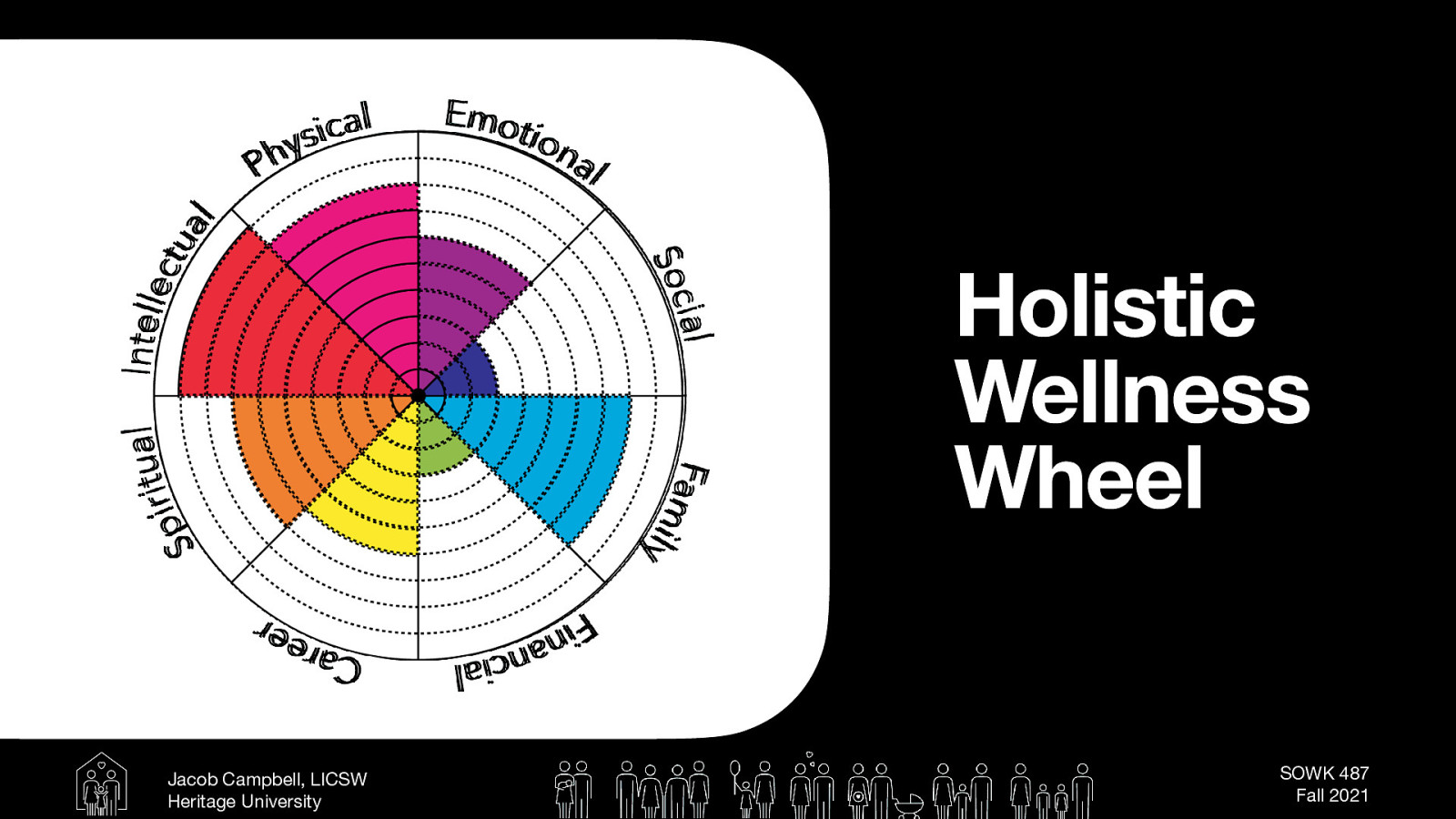
Wellness Wheel
The wellness wheel is not an activity I did as frequently with families as I did with individuals, but it it still works just as well.
[Whole Class Activity] Have entire class complete a wellness wheel themselves, walking them through questions.
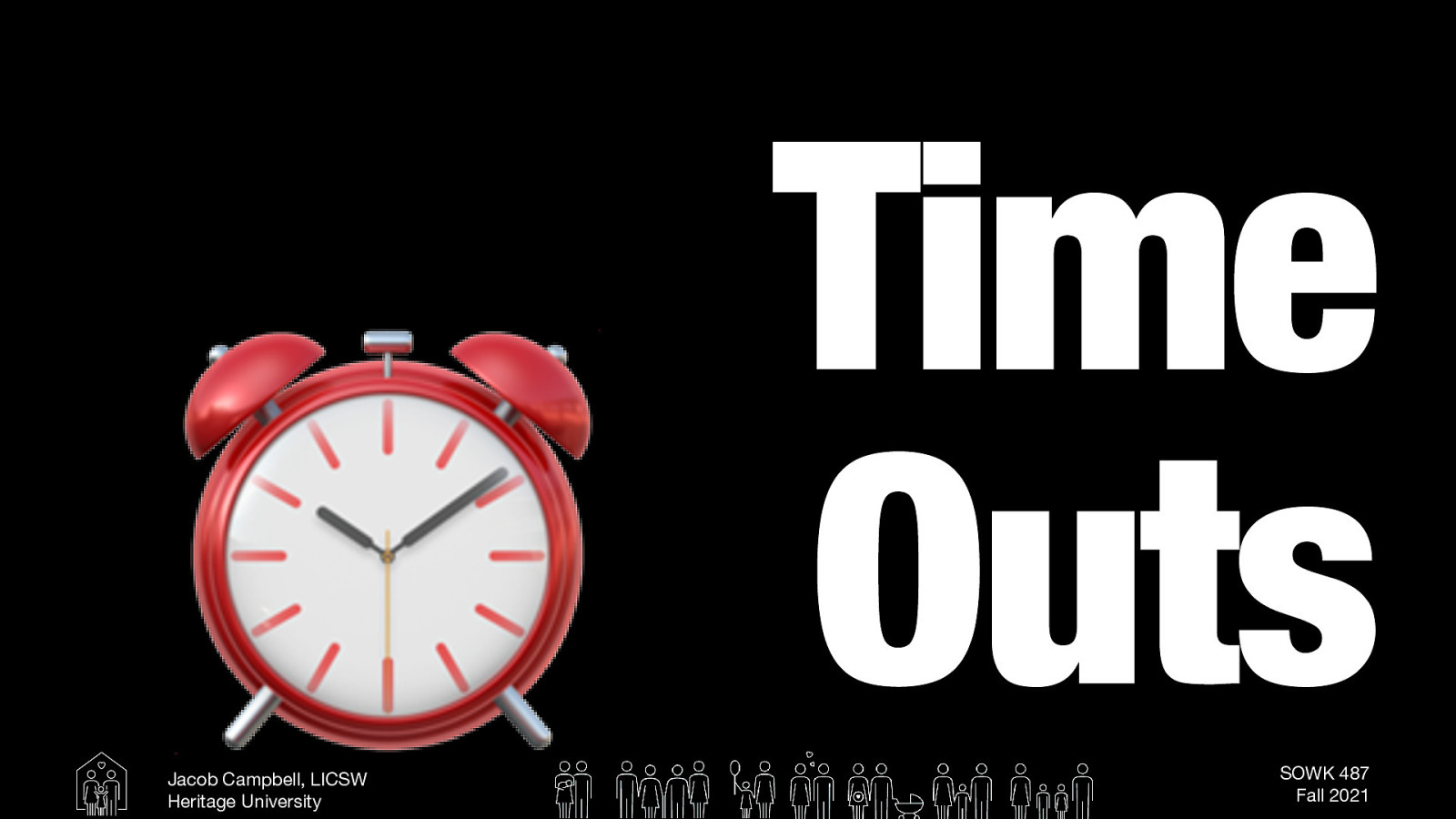
Time-Outs
This is another form that I thought I’d share with you. It’s a pretty simple concept. Sometimes it can be really beneficial for our clients if we can make things simple and clearly defined.
While, I don’t have other examples for you, similar style handouts could be made and used…
- Using I-Messages
- Eriksons stages of development
- …etc
Week five, we continue to focus on working with families. Students are expected to read Prest and Protinsky (1993). We will continue to talk about the dimensions of family assessments. The class session should be fairly practical with several activities. The agenda is as follows:
- Finish reviewing dimensions of family systems framework assessment
- Specific tools for working with families
- Dysfunctional family roles
